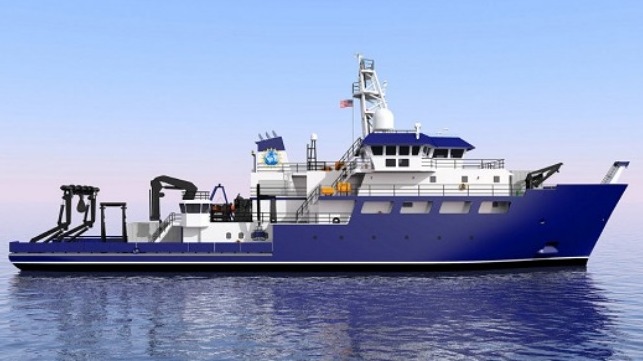Oregon State University Orders Second U.S. Research Ship

Oregon State University has received $88 million from the National Science Foundation to lead construction of a second Regional Class research vessel to help bolster the nation’s aging academic research fleet.
The National Science Foundation selected Oregon State in 2013 to lead the initial design phase for as many as three new vessels, and the National Science Board authorized as much as $365 million for the project. Last summer, the National Science Foundation awarded Oregon State University a grant of $121.88 million to launch the construction of the first vessel, which Gulf Island Shipyards in Louisiana is building and the university will operate. It was the largest grant in the university’s history. The yard is about to begin physical construction of the vessel, which is scheduled to be delivered to Oregon State in spring of 2021, and fully operational after a year of outfitting and testing.
After receipt of the additional $88 million, the university exercised an option within its contract with Gulf Island to construct and outfit the second ship. The National Science Foundation is in the process of identifying and selecting an institution to operate this second vessel – likely situated on the Atlantic Ocean or the Gulf of Mexico, according to Demian Bailey, project co-leader for Oregon State University. The second ship is expected to be delivered to its operating institution sometime after the fall of 2021.
The new ships are essential to support near-shore research as the U.S. and other countries face unprecedented challenges to their coastal waters, said Roberta Marinelli, dean of Oregon State’s College of Earth, Ocean, and Atmospheric Sciences. “Rising sea levels, ocean acidification, low-oxygen waters or ‘hypoxia,’ sustainable fisheries and the threat of catastrophic tsunamis are issues not only in the Pacific Northwest, but around the world,” Marinelli said. “These new vessels will provide valuable scientific capacity for better understanding our changing oceans.”
The ships will be equipped to conduct seafloor mapping, which has become of significant importance following devastating tsunamis triggered by subduction zone earthquakes in Indonesia and Japan. The Pacific Northwest is considered a high-risk region because of the Cascadia Subduction Zone, which has produced numerous major earthquakes of magnitude 8.0 or greater over the past 10,000 years.
Almost identical to the first vessel, the second will feature:
• A length of nearly 200 feet long and a range of more than 7,000 nautical miles;
• A cruising speed of 11 knots, with a maximum speed of 13 knots;
• 16 berths for scientists and 13 for crew members;
• The ability to stay out at sea for 21 days before returning to port for fuel and supplies.
Clare Reimers, a professor in the College of Earth, Ocean, and Atmospheric Sciences and project co-leader said the vessel will offer real-time data connectivity to shore and more capability for over-the-side operations. “The design also has numerous ‘green’ features, including an optimized hull form, waste heat recovery, LED lighting and variable speed power generation.”
